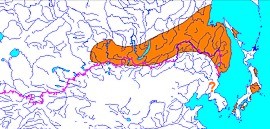|
 SCIENTIFIC
NAME: Murina hilgendorfi Peters, 1880 SCIENTIFIC
NAME: Murina hilgendorfi Peters, 1880
COMMON NAMES: Greater tube-nosed bat, Siberian tube-nosed bat
SYNONYMS: sibirica Kastschenko, 1905; ognevi Bianchi,
1916; intermedia Mori, 1933.
DIMENSIONS: Body mass ca. 7-13 g, head and body length 50-60 mm,
tail length 35-40 mm, forearm length 36-44 mm, wingspan ca. 25-31
cm.
DESCRIPTION: Fur dense and soft, grayish to reddish-brown on upperparts,
with conspicuously splendent individual long hairs. Underpart coloration
more light, grayish. Wing membranes grayish-brown, muzzle dark.
Ears broadly rounded, with conspicuous emargination on posterior
border. Dentition robust and massive.
DISTRIBUTION: Distributed sparsely in Altai, southern and south-eastern
Siberia, Baikal lake, Transbaikalia and Russian Far East, also in
nothern China, Japan and probably Corea.
NATURAL HISTORY: Inhabits hilly and mountainous areas, up to 4000
m ASL, with mixed coniferous-broadleafed and broadleaved forests
and usually with underground cavities. Day roosts were foung in
tree canopies and other tree- or timber-associated shelters (under
loose bark, in firewood piles, etc.), and also in caves. Life habits
are poorly known. Apparently insectivorous, probably a ground-gleaner
(at least in part), picking its prey from soil or vegetation surface.
The foraging flight is powerful and maneuverable. While foraging,
this species may also extensively use quadrupedal ground locomotion.
Echolocation signal is an FM sweep from 112 to 40 kHz, with maximum
energy around 50-80 kHz. Births probably occur in the beginning
of summer. Females do not form large nursing colonies and possibly
live solitarily. One or two young are produced in each litter. A
resident species, hibernating in caves, were it can form aggregations
up to several hundreds of individuals. Maximum recorded longevity
is up to 16 years (usually ca. 5-9).
STATUS: A widespread species, inhabiting low populated areas. Rarely
recording but probably more common than it was thought previously.
IUCN: Not listed.
|






